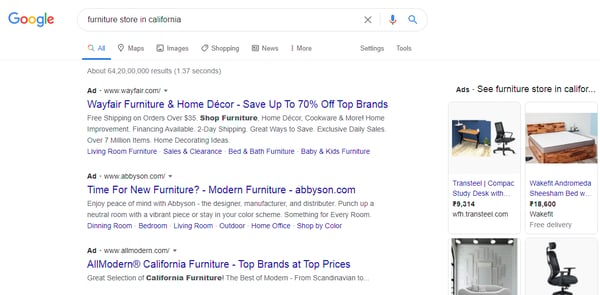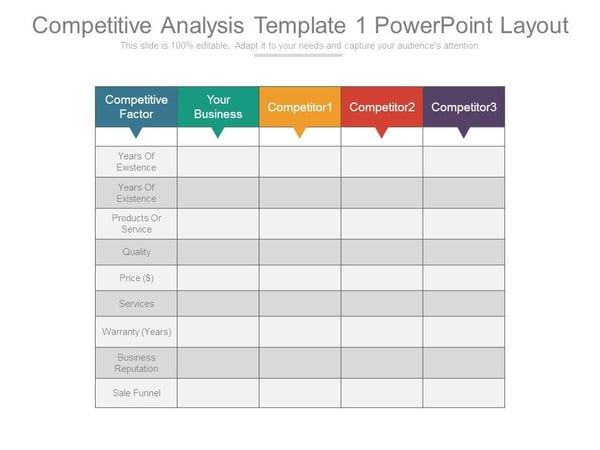October 16, 2020
 by Dwayne Charrington / October 16, 2020
by Dwayne Charrington / October 16, 2020

It's common for entrepreneurs to receive the advice that their business needs to stay one step ahead of the competition or else they will be swallowed by the big sharks.
But as a business, how can you stay ahead in the game – especially when sharks are plenty and they're hungrier than ever?
Competition in the business world is inevitable. On one hand, it drives entrepreneurs to produce the best products that the market has ever seen. On the other hand, it's the reason why a majority of businesses never make it to their second year. Carlos Slim once said: “Competition makes you better, always, always makes you better, even if the competitor wins.”
With around 550,000 businesses that start every month, your competitor list will continue to expand. But should that stop your business from becoming its best self?
Of course not. Whether you’re new to your market, or a veteran with plenty of industry experience, this blog shares a step-by-step guide for competitor analysis that will help you stay multiple steps ahead of your rivals.
So...are you ready to embrace your competition?
At some point in time, you might have wondered why companies spend thousands of dollars just to understand their competitors? Why not spend this money on marketing instead?
Well, many modern businesses fail to realize that in order to successfully market their product they need to understand the market and the key business players who are working day and night to expand their reach. No wonder that competitive analysis is considered a critical part of any company's marketing plan.
A competitive analysis is a process of identifying and evaluating your competitors to understand their strengths and weaknesses in contrast to your own.
The underlying idea is simple. With the results from your competitive analysis, you can develop strategies to foil competition from entering the market, identify any weaknesses of your rivals that can be exploited, and above all, win more customers.
A competitor analysis can help you find answers to some of the most common questions that are known to keep the best of entrepreneurs awake at night. Here are some of them:
Now, let’s explore the importance of competitor research and why it’s necessary for business longevity.
Modern businesses are heavily investing in competitive research (or competitive intelligence) to identify their top competitors, track their actions, understand how they are wooing customers, and evaluate the threat that they present to other similar businesses.
Competitive research is one part of the process of collecting and analyzing rivals’ content, data, and impact. But is competitor research really important?
Every business that exists has competitors. Even if you have the most unique idea in the world, sooner or later, there will be a business in operation who will inevitably become your first – or next – competitor.
This is exactly where competitor research comes to the picture and helps your business stay afloat in a crowded marketplace.
Here are some top advantages:
According to Crayon’s 2020 State of Competitive Research, more businesses are looking to develop a team solely dedicated to competitor intelligence (CI). Where 57% of businesses have CI teams of two or more, it is 20% more than just two years ago (37%).
There are countless ways to learn better about your top competitors, but here are a few that will get the job done in no time. Let’s go through the six steps your team should be taking when conducting a competitive analysis.
Most businesses make the grave mistake of assuming that they already know their competitors and believe they can almost count them on their fingertips.
You need to drop the “know-it-all” attitude and start with a learning mindset. No matter which market your business operates in, dynamics are always changing. There are always new entrants in the market and there are others that eventually have to take the exit route.
When it comes to spotting your top competitors, Google can be your best friend. Suppose you have a furniture business based out in California. Simply searching “furniture store in California” will not only help you identify your competitors, but it will also help you see which brands are running paid advertisements to make their website appear at the top.

From the image above, it’s clear that brands like Wayfair and AllModern are going the extra mile to promote their online store.
Sometimes, the search results might show you content (blogs, articles) instead of business names. It is important to note that anyone (individual/business) writing content around your value proposition or the problem your business is solving, can be a potential competition. Moreover, you can explore related community forums or social media groups/pages and see the brands that people are talking about the most.
Marketing is no more about advertising your brand on big billboards. Every modern business is on a spree to create and publish relevant content for their existing, as well as the target audience.
Content isn’t king anymore. Relevant content is.
As an entrepreneur, you need to research the types of content your competitors are creating (blogs, images, videos, webinars, etc.) to grab consumer attention. For this, you can simply visit their online website, explore their social media pages, or scroll through their YouTube channel.

Once you’ve got your hands over some of their top-ranking content, you can ask yourself questions like:
With the help of content research, you can analyze your competitors' existing content, the keywords they are targeting, and for different ways to differentiate your brand's content.
A teacher might have told you to focus on the positive things in life. However, when it comes to business, focusing on the negative aspects of your competitors can help you improve.
Keep a keen eye on every loophole present in their business process, track every mistake they are making, and dig for their weak points. Don’t worry! Sometimes, it’s alright to spy on your competitors.
It’s time to go Sherlock on your business rivals!
You can start by signing up for their newsletters and see how frequently they are communicating with their audience. Keep a close eye on the language they are using- is it too friendly? or is it too professional?
Try purchasing their product and thoroughly monitor the materials, the overall quality, aesthetics, and more. For instance, if you are in the women’s apparel business, order a few dresses and examine the quality of fabric they are using, the color scheme, the stitching, the overall design – you get the picture.
You can also try returning the same product and see if returning the purchased items is as hassle-free as the company claims it to be. Or maybe, you can add a few items to the cart and abandon the checkout process. See if the business attempts to communicate back to understand the reason behind the abandonment.
In addition to this, you can try to register a complaint. Check how quickly their customer service team offers assistance and resolves your request. You might want to use more than one channel to contact the business and see on which channels they are proactive.
The purpose here is not to act as a critique to your competitors, but to learn and look for those tiny opportunities where your business can hit the mark.
To understand any business, you don’t need to visit their brick and mortar store or office. All the information you need about them is just a click away. Companies are investing heavily on their business website more than ever and they have obvious reasons for it. Seventy-five percent of consumers admit to making judgments on a company's credibility based on the company's website design.
Therefore, you need to closely monitor every competitor’s website and ask questions like:
The truth is that every website is going to be different. Through careful examination of their strengths and weaknesses, you can design your business website that has the power to convert maximum visitors into paying customers.
There are plenty of tools in the market that can help you significantly enhance your competitor analysis efforts.
If you want to steer past your competitors, you need to outperform them in many aspects. But is that even possible? How can a small business compete on pricing?
Well, that’s true you cannot possibly compete in every single area. However, you can always focus on your own strengths. Focus on how you can improve your existing process and identify your brand’s unique selling point. For instance, Tony Hsieh, CEO of Zappos, has repeatedly claimed that their USP is not their footwear design or functionality; instead, it is their reliable customer service.
Once you've gained a better understanding of what your competitors are doing right and what they are doing wrong, you can finally reflect on your own process. For instance, if they have a strong social media presence, you can take inspiration from the type of content that they are posting. Look for ways on how you can reach out to more people, and engage your customers better than any other business.
Now that you have gathered all the key data about your leading competitors, how do you present it for easy comparison?
A competitor analysis template holds the right answer. Such a template is designed to represent a detailed analysis of what your competition has to offer, from pricing to marketing tactics, the potential is endless. This template is quite like a chart that showcases a wealth of information about all your competitors that you can view at a glance.

Now when it comes to competitor analysis templates, there is no one-size-fits-all approach. You need to include parameters that are critical to your business. You can compare on key parameters like:
The list is endless. Once you have the required data at hand, simply choose the crucial parameters and you’re good to go.
We understand, an ever-increasing competition can be a tough pill to swallow. You have to go head-to-head with dozens of businesses to win the loyalty of the same audience. This isn’t child’s play! But then again, nothing great was ever achieved sitting in a place called the comfort zone.
A strong competitive analysis might take a lot of work, but the rewards you get are worth every single effort. With consistent analysis, you can stay updated with key industry trends, customer expectations, and uncover those crucial areas of need that have not been met by any other business.
All successful entrepreneurs have a thing in common- they thrive under competitive pressure. So instead of seeing competition as a hurdle, see it as the biggest opportunity to take your business to the next level.
Dwayne Charrington is a technical writer for ProProfs Help Desk. He possesses hands-on experience in writing for the customer service industry. He shares insights on industrial challenges, customer service trends, and how businesses overcome related challenges.
With the competition steeper than ever, brands must find a way to differentiate themselves and...
 by Jared Gardner
by Jared Gardner
Marketing means conferences and conferences mean planning. All of this can lead to a big...
 by Lyndsey Hrabik
by Lyndsey Hrabik
Even the most passionate and driven content creators can feel overwhelmed when faced with the...
 by Piper Thomson
by Piper Thomson
With the competition steeper than ever, brands must find a way to differentiate themselves and...
 by Jared Gardner
by Jared Gardner
Marketing means conferences and conferences mean planning. All of this can lead to a big...
 by Lyndsey Hrabik
by Lyndsey Hrabik


